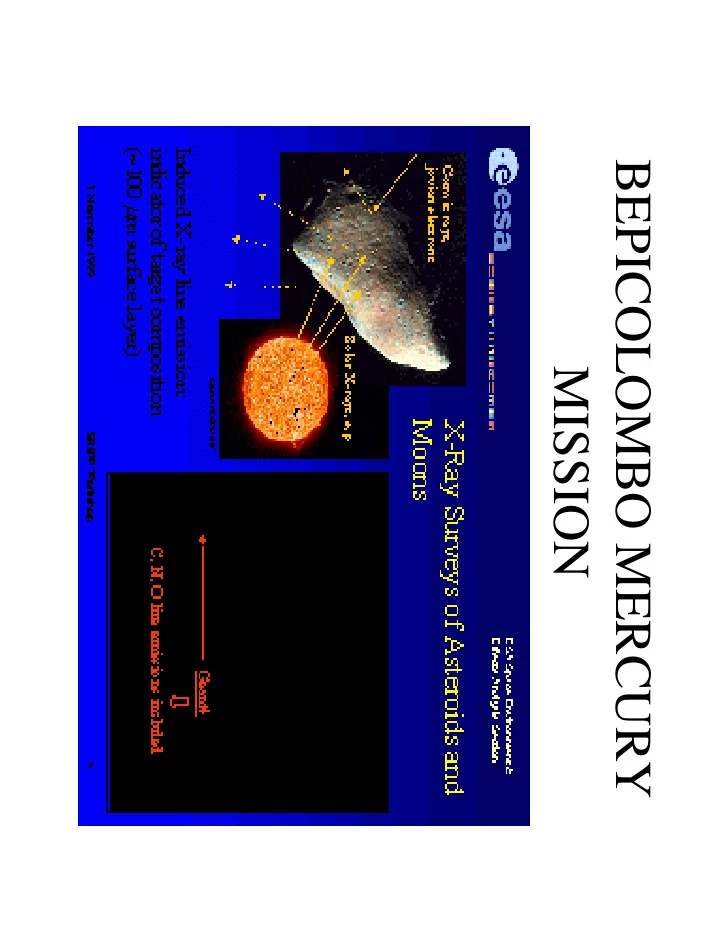

BEPICOLOMBO MERCURY MISSION
The main questions about Mercury •Why Mercury is so dense? •What is the geological history of Mercury? •What is the structure of Mercury’s core? •What is the nature of Mercury’s magnetic field? •What are the unusual materials at Mercury’s poles? •What is on the unseen hemisphere of Mercury? •What new constraints can we set on general relativity and gravitational theories?
The spacecraft Multi-spectral imaging, IR,UV,X-ray spectrometer, Neutron spectrometer, K-ray transponder, Accelerometer, Altimeter Magnetometer, Ion spectrometer Electron electrostatic analyzer Cold and energetic plasma detectors Plasma wave analyzer In situ chemical and mineralogical observations on the surface of Mercury
The physics It arises from the solar X-ray flux, sufficient, for the inner planets, to fluorescence significant fluxes to an orbiter Significant only during particle events, during which it can exceed XRF The goal Developing surface maps of absolute concentrations for the various major elements
•Feasibility study for the experiment •Optimization of the detector by a forecast of the experimental results ESA Proposal •The work will be concluded within the end of December 2001 •The proposal is being released in spring 2002
The project plane of the experiment is cyclic in the way of developing: • a first approximate instance of the experimental set-up will be constructed, with a simple cube as a target of a monochromatic beam •a test beam with an similar set-up will take place, and the experimental results will be compared with those coming from the simulation in order to test its code • the virtual set-up will be modified and made closer to the final one •another test beam will take place and the results will be compared again •After a number of tests the definitive simulation will be written, with the planet Mercury as the target of a beam whose composition will be provided by ESA Space Environment Section
A beam of photons of 100 keV is shot on a sample... Incident beam sample Here will be the detector
Iron: all the photons leaving the sample
Radiative Transitions of Fe Subshell Transition probability Emitted Photon(eV) K L2 1.01391 -1 6349.85 K L3 1.98621 -1 6362.71 K M2 1.22111 -2 7015.36 K M3 2.40042 -2 7016.95 L2 M1 4.03768 -3 632.540 L2 M4 1.40199 -3 720.640 L3 M1 3.75953 -3 619.680 L3 M5 1.28521 -3 707.950
GaAs: all the photons leaving the sample
Radiative transitions of Ga Subshells Transition Probability Emitted Photon(eV) K L2 1.49780 -1 9180.60 K L3 2.91200 -1 9209.00 K M2 1.89300 -2 10220.0 K M3 3.69890 -2 10223.7 L1 M3 1.28631 -3 1183.42 L2 M1 4.43283 -3 992.650 L2 M4 7.53404 -3 1123.03 L3 M1 4.30092 -3 964.250 L3 M5 6.71294 -3 1095.13
Radiative transitions of As Subshell Transition Probability Emitted Photon (eV) K L2 1.66890 -1 10463.3 K L3 3.23251 -1 10500.7 K M2 2.20590 -2 11680.0 K M3 4.30891 -2 11685.2 K N3 1.29230 -3 11821.2 L1 M3 1.55206 -3 1375.42 L2 M1 3.97241 -3 1163.68 L2 M4 1.12390 -2 1314.38 L3 M1 4.16398 -3 1126.28 L3M5 1.00090 -2 1277.75
GaAs + Fe: all the photons generated (1) and leaving the sample (2) Fe lines GaAs lines GaAs lines Fe lines Scattered photons
Basalt: all the photons leaving the sample
• Tested x-ray emissions from different materials • Reproduction of the experimental set up of the test beam • Comparison of the data from the test beam with those from the simulation •Reproduction of the surface of Mercury (from a model provided by the Astrophysic Division of ESTEC) •Reproduction of the incident solar beam (from a model provided by Petteri Nieminen’s group) •Insertion of the detector (from the work of Simeone Dussoni) •Effects of the losses of photons due to the bodies interposed between the detector and the planetary surface
Recommend
More recommend